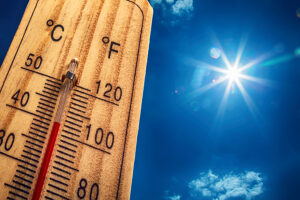Extreme heat and heat related deaths are closely linked. A record heat wave hit the North West of the US and British Columbia in late June/early July. Many people died from heat stroke and from cardiovascular problems. Here I like to review the medical literature regarding extreme heat and heat related deaths. Also, why is it important to cool down? Much of what I like to communicate was published in a review article by CNN. But I also reviewed many other websites and added links below.
How does global warming contribute to the summer heat?
There are a few explanations how global warming drives the heat in summer even higher. Essentially, what weather experts are saying is that the jet stream can get stuck in one place during a summer heat wave and the heat keeps getting more intense. Global warming is responsible for heat waves that are higher than in the past. Conversely, in winter global warming can produce cold waves that are colder than in previous years.
Why is extreme heat dangerous for us?
According to the CDC between 2004 and 2018 an average of about 700 Americans died from heat-related causes. The majority of deaths occurred between May and September. There are a number of observations that explain why more people die during a heat wave.
In 2006 there were widespread heat waves and as a result there was a peak in heat related deaths.
- When people have pre-existing cardiovascular disease, this gets aggravated during a heat wave and the death rate from cardiovascular disease increases during a heat wave. About 25% of heat related deaths are due to an underlying cardiovascular disease.
- Age by itself plays a big role in heat related deaths. People above the age of 65 are several times more likely to die from a heat related cardiovascular disease than the general population.
Under reporting of heat related deaths
- Many times, it is not clear whether a death is due to a medical condition or due to exposure to heat. A death certificate that reports a heart attack as the cause of death during a heat wave will be missed when statisticians attempt to get a number for heat related deaths after a heat wave.
Medical causes why extreme heat and heat related deaths are linked
Our body is used to an inside temperature range between 97 to 99 degrees Fahrenheit (36.1 to 37.2 degrees Celsius). The body can compensate in two ways to counter a rise of the body temperature from heat exposure.
- When the brain senses a rise in body temperature, the sweat glands open up and sweat is produced. The evaporating sweat cools down the body temperature.
- The body has a second coping mechanism to cool you down. The body can dilate its blood vessels and increase the heart rate. This brings the blood more to the surface. This is when your forehead and the extremities give off heat and you lower your body temperature.
- But with exposure to extreme high temperatures both of these mechanisms are not enough to decrease your core temperature.
Avoiding heat-related illness
- The Mayo Clinic link explains that it is important to drink enough fluids to avoid dehydration. This helps with the second coping mechanism mentioned that cools you down (see above).
- When the outside temperature rises beyond 86 degrees Fahrenheit (=30 degrees Celsius) it is wise to stay inside air-conditioned premises. This could be your house, if you have air-conditioning, an air-conditioned mall or a public building. A cool pool, bathtub, or cold cloths applied to your arms, legs and torso cool you down as well. Otherwise, intermittent cold showers or cold baths will do the same.
Health conditions that are a higher risk for heat related deaths
The population group at higher risk for developing heat-related illness and eventual deaths are infants and children up to age 4. In addition, anybody older than 65 years is also at risk. Pre-existing medical conditions like diabetes, heart disease and chronic lung disease (COPD) increase the risk of dying from excessive heat exposure. Being overweight or obese is also a risk factor. Heat exhaustion and heat stroke are conditions that require hospitalization.
Common heat-related symptoms
Symptoms of heat exhaustion are: profuse sweating, a pulse that is fast and weak, clammy skin, vomiting and nausea. In addition, there can be cramps in muscles, weakness, tiredness, dizziness, headaches and fainting.
Symptoms of heat stroke are: high fever of 104 degrees Fahrenheit (= 40 degrees Celsius) or higher. Take the temperature with a rectal thermometer to get the core temperature. Other symptoms of heat stroke are altered mental state (confusion, agitation, delirium and seizures). Further, the skin may turn red as the temperature increases, and there may be rapid and shallow breathing. The heartbeat races and the head may throb from a severe headache. Both patients with heat exhaustion and heat stroke need hospital care. Call an ambulance.
Conclusion
We have to take extreme heat and heat related deaths seriously. Only when we employ counter measures will the death toll from heat related deaths go down. Prevention is everything. But if a person develops heat exhaustion and heat stroke swift transportation to a hospital is a must. This can often save a life. We all need adopt an awareness what our risks are regarding heat and heat related deaths. We need to apply early countermeasures by getting into cooler areas and by drinking enough fluids to prevent dehydration. Prevention is everything regarding extreme heat and heat related deaths.






